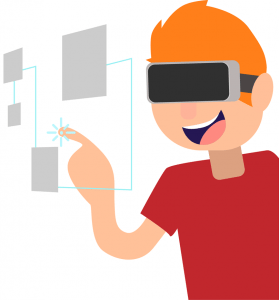CALL: 985-778-0798
Moving Towards Virtual Reality: How Did We Get Here?
Virtual Reality is no longer just a plot for a movie about the future, nor is it just limited to video gamers. Goldman-Sachs stated, “We see qualities in VR/AR technology that can take this from nice use case to a device as ubiquitous as the smartphone.” Marketing and media experts say VR advertising could completely change the marketing game within the next two years.
71% of consumers think a brand that uses virtual reality is forward thinking. VR is predicted to impact nearly every industry, but in particular, education, travel, journalism, health care, architecture, and marketing. Just as businesses had to make their web presence responsive for mobile, they will soon have to become accessible with VR. Typically, many brands will rush to utilize new technology and techniques before they understand the platform. It is imperative to look first at what other brands are currently doing with virtual reality.
TOMS, a shoe brand that rose to fame in 2006 by also being a charity to underprivileged kids, has already begun utilizing VR. TOMS takes their users to a remote village in Peru where they show the consumers how their TOMS purchase helps children in need. The user not only knows that each time they buy a pair of TOMS that it another pair goes to a kid in need, but also they experience that exchange themselves and, suddenly, it becomes real.
Mercedes has quickly risen to the occasion as well and showed off it’s latest SL model with a virtual drive on the Pacific Coast Highway in California. With the tool of virtual reality, users were able to look around the interior of the car, peer up through the sunroof, and watch as the car navigated through the road. This virtual experience also explored the convertible mode, where the user can see the Pacific Ocean. This experience is the closest consumers can get to test drive a car without actually test driving it.
While some claim the world may not be ready for VR technology, videos utilizing the tech have already racked up millions of views. A VR viewer that can attach to any phone called Google Cardboard has sold millions of units and has millions of clicks on its related videos. Forward thinking companies will recognize the appeal of VR advertising. VR immerses you in a virtual world from all angles, naturally, this would make VR advertising the most immersive form of marketing. Imagine an advertisement that is more than a static video, but an immersive world designed for the viewer to explore as they familiarize themselves with your brand. This is the world Velocity Agency is helping create!
Marketing experts are monitoring what they think will be highly useful in the marketing and media world. Imagine that you are in the market to find a hairstylist, and suddenly Virtual Reality could let you tour different salons before you make your decision. This is just one instance of how VR will help consumers make educated purchases. The question is not when will VR be widely used, but is your brand ready?

